Management Accounting: Report, Analysis, and Financial Reporting
VerifiedAdded on 2022/12/26
|29
|4421
|90
Report
AI Summary
This report delves into the core concepts of management accounting, encompassing its systems, applications, and integration within organizational processes. It begins by defining management accounting and its significance in providing crucial information to managers for effective decision-making. The report explores various management accounting systems, including inventory management, job costing, and price optimization, detailing their key features and benefits. It then critically evaluates the integration of these systems within organizational frameworks. The report presents financial reporting documents, including income statements and cost of goods sold calculations, along with detailed analyses using techniques like high-low method, FIFO, LIFO, and weighted average costing. Finally, it covers break-even analysis and profit calculations, providing a comprehensive overview of management accounting principles and their practical application in business scenarios.
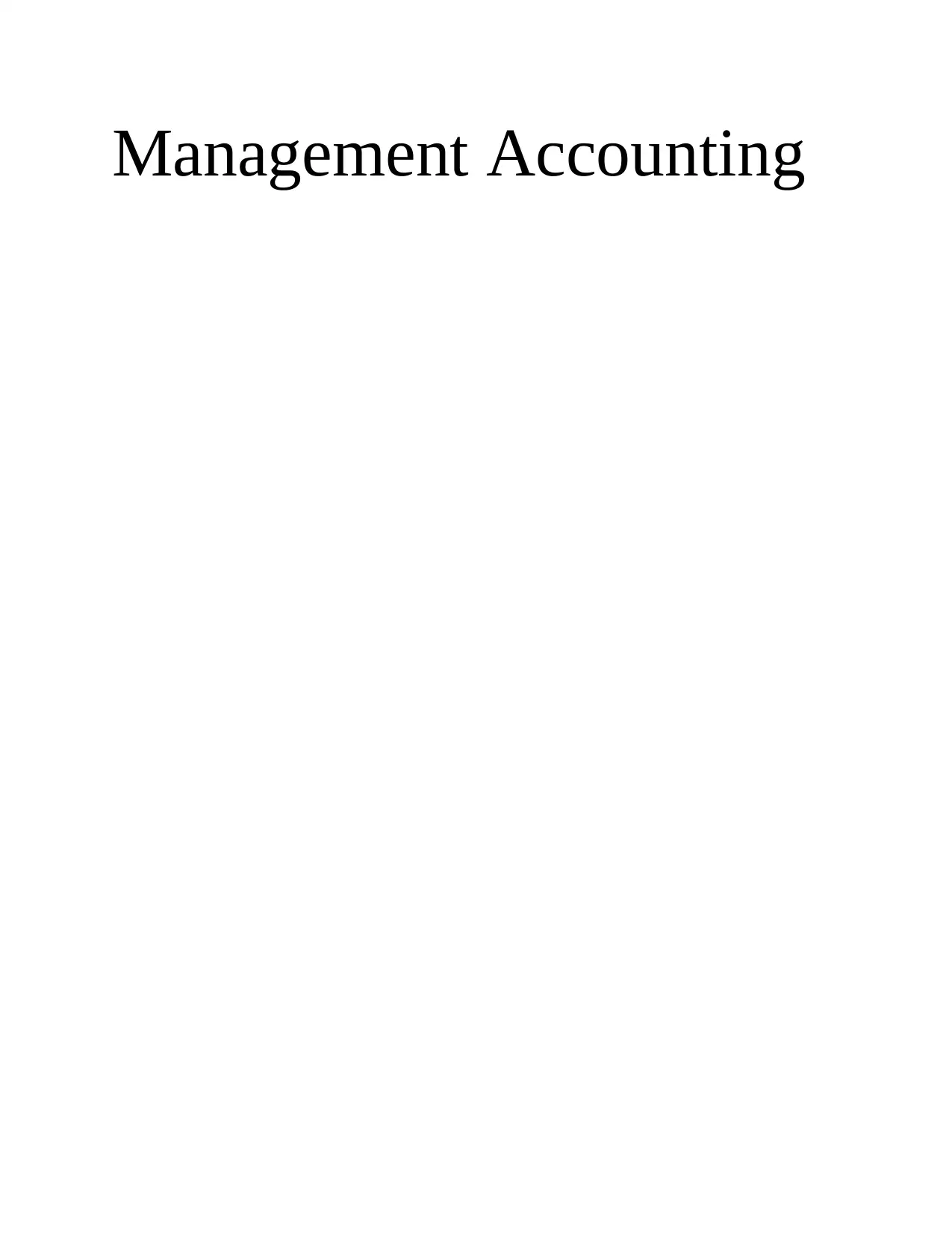
Management Accounting
Paraphrase This Document
Need a fresh take? Get an instant paraphrase of this document with our AI Paraphraser
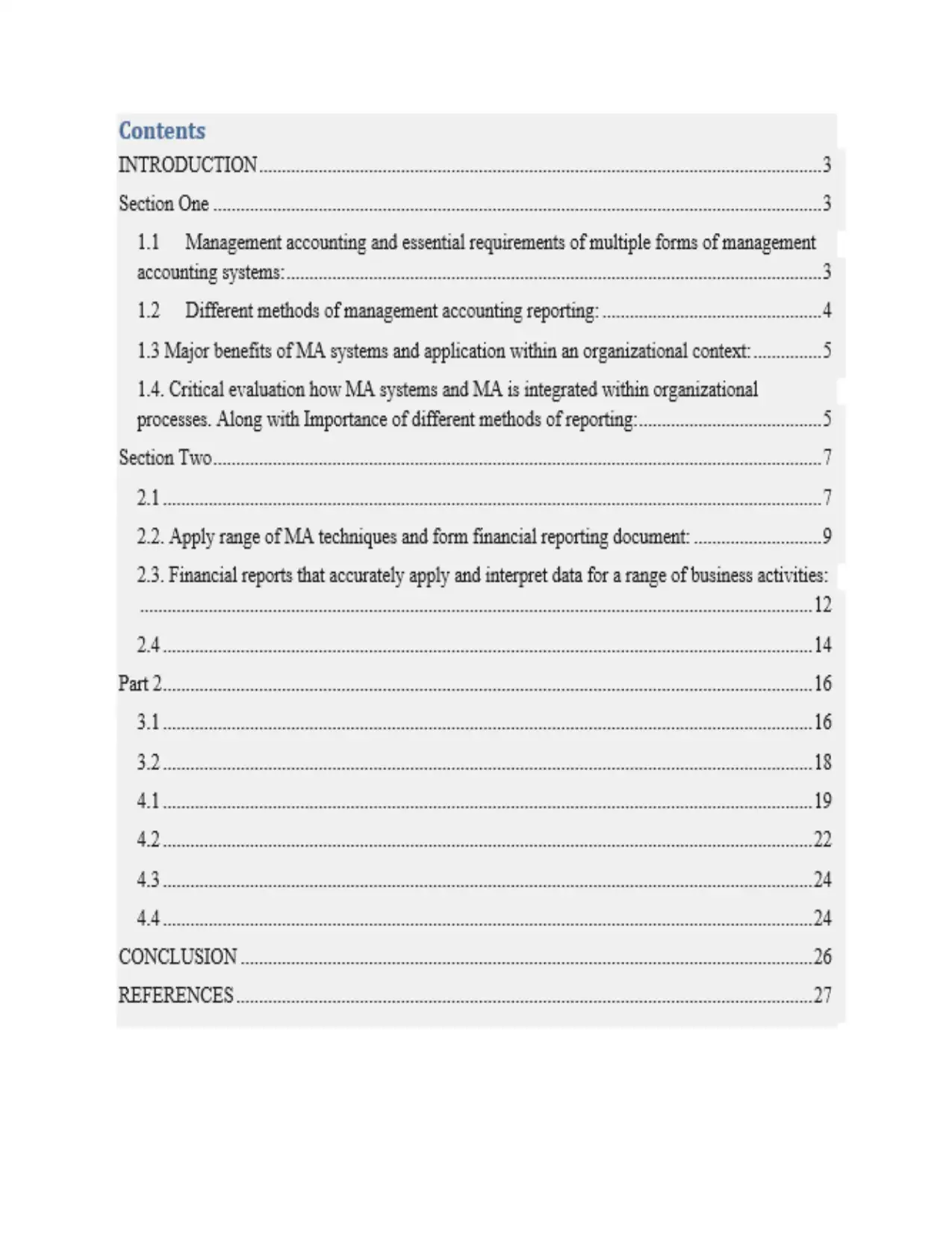
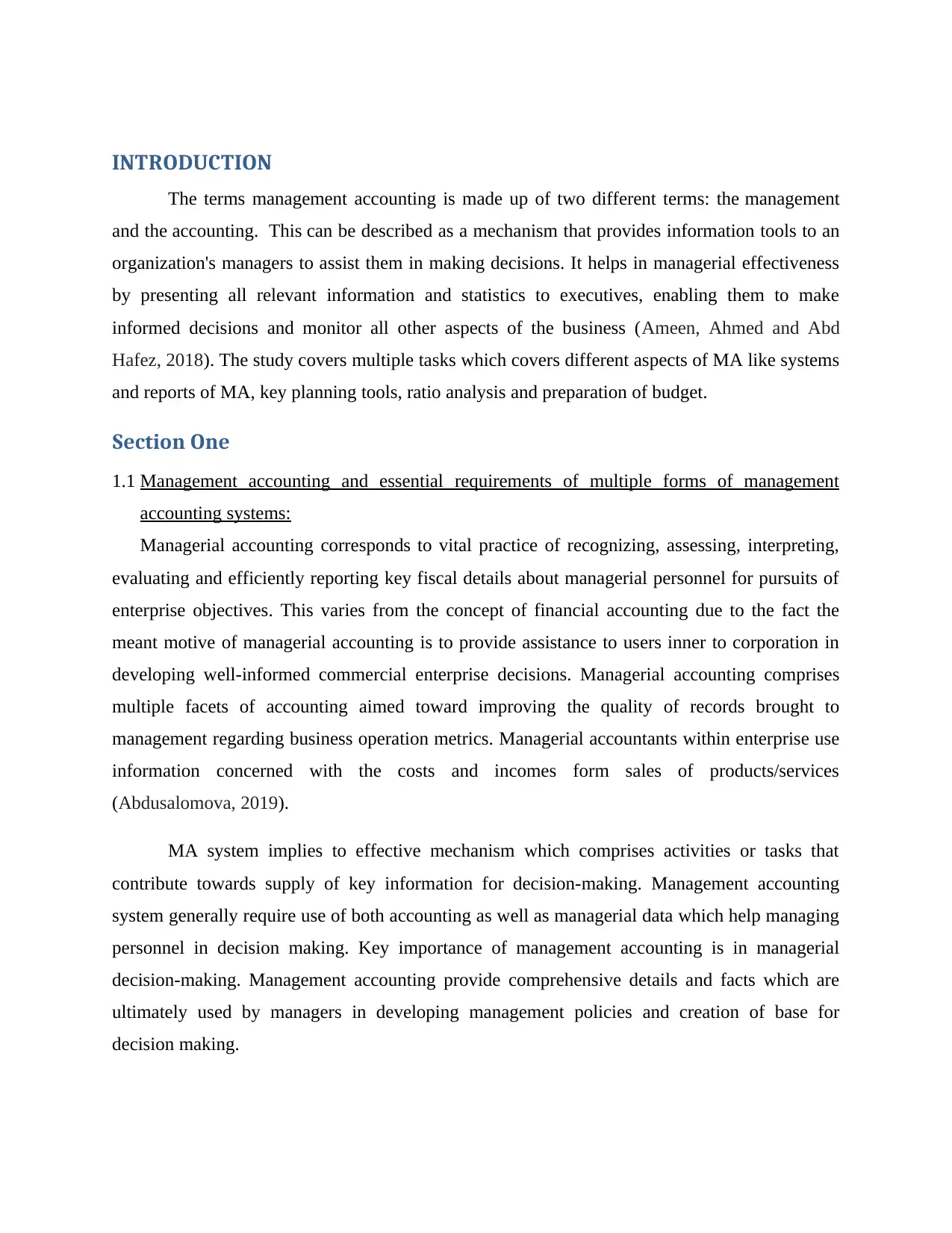
INTRODUCTION
The terms management accounting is made up of two different terms: the management
and the accounting. This can be described as a mechanism that provides information tools to an
organization's managers to assist them in making decisions. It helps in managerial effectiveness
by presenting all relevant information and statistics to executives, enabling them to make
informed decisions and monitor all other aspects of the business (Ameen, Ahmed and Abd
Hafez, 2018). The study covers multiple tasks which covers different aspects of MA like systems
and reports of MA, key planning tools, ratio analysis and preparation of budget.
Section One
1.1 Management accounting and essential requirements of multiple forms of management
accounting systems:
Managerial accounting corresponds to vital practice of recognizing, assessing, interpreting,
evaluating and efficiently reporting key fiscal details about managerial personnel for pursuits of
enterprise objectives. This varies from the concept of financial accounting due to the fact the
meant motive of managerial accounting is to provide assistance to users inner to corporation in
developing well-informed commercial enterprise decisions. Managerial accounting comprises
multiple facets of accounting aimed toward improving the quality of records brought to
management regarding business operation metrics. Managerial accountants within enterprise use
information concerned with the costs and incomes form sales of products/services
(Abdusalomova, 2019).
MA system implies to effective mechanism which comprises activities or tasks that
contribute towards supply of key information for decision-making. Management accounting
system generally require use of both accounting as well as managerial data which help managing
personnel in decision making. Key importance of management accounting is in managerial
decision-making. Management accounting provide comprehensive details and facts which are
ultimately used by managers in developing management policies and creation of base for
decision making.
The terms management accounting is made up of two different terms: the management
and the accounting. This can be described as a mechanism that provides information tools to an
organization's managers to assist them in making decisions. It helps in managerial effectiveness
by presenting all relevant information and statistics to executives, enabling them to make
informed decisions and monitor all other aspects of the business (Ameen, Ahmed and Abd
Hafez, 2018). The study covers multiple tasks which covers different aspects of MA like systems
and reports of MA, key planning tools, ratio analysis and preparation of budget.
Section One
1.1 Management accounting and essential requirements of multiple forms of management
accounting systems:
Managerial accounting corresponds to vital practice of recognizing, assessing, interpreting,
evaluating and efficiently reporting key fiscal details about managerial personnel for pursuits of
enterprise objectives. This varies from the concept of financial accounting due to the fact the
meant motive of managerial accounting is to provide assistance to users inner to corporation in
developing well-informed commercial enterprise decisions. Managerial accounting comprises
multiple facets of accounting aimed toward improving the quality of records brought to
management regarding business operation metrics. Managerial accountants within enterprise use
information concerned with the costs and incomes form sales of products/services
(Abdusalomova, 2019).
MA system implies to effective mechanism which comprises activities or tasks that
contribute towards supply of key information for decision-making. Management accounting
system generally require use of both accounting as well as managerial data which help managing
personnel in decision making. Key importance of management accounting is in managerial
decision-making. Management accounting provide comprehensive details and facts which are
ultimately used by managers in developing management policies and creation of base for
decision making.
⊘ This is a preview!⊘
Do you want full access?
Subscribe today to unlock all pages.

Trusted by 1+ million students worldwide
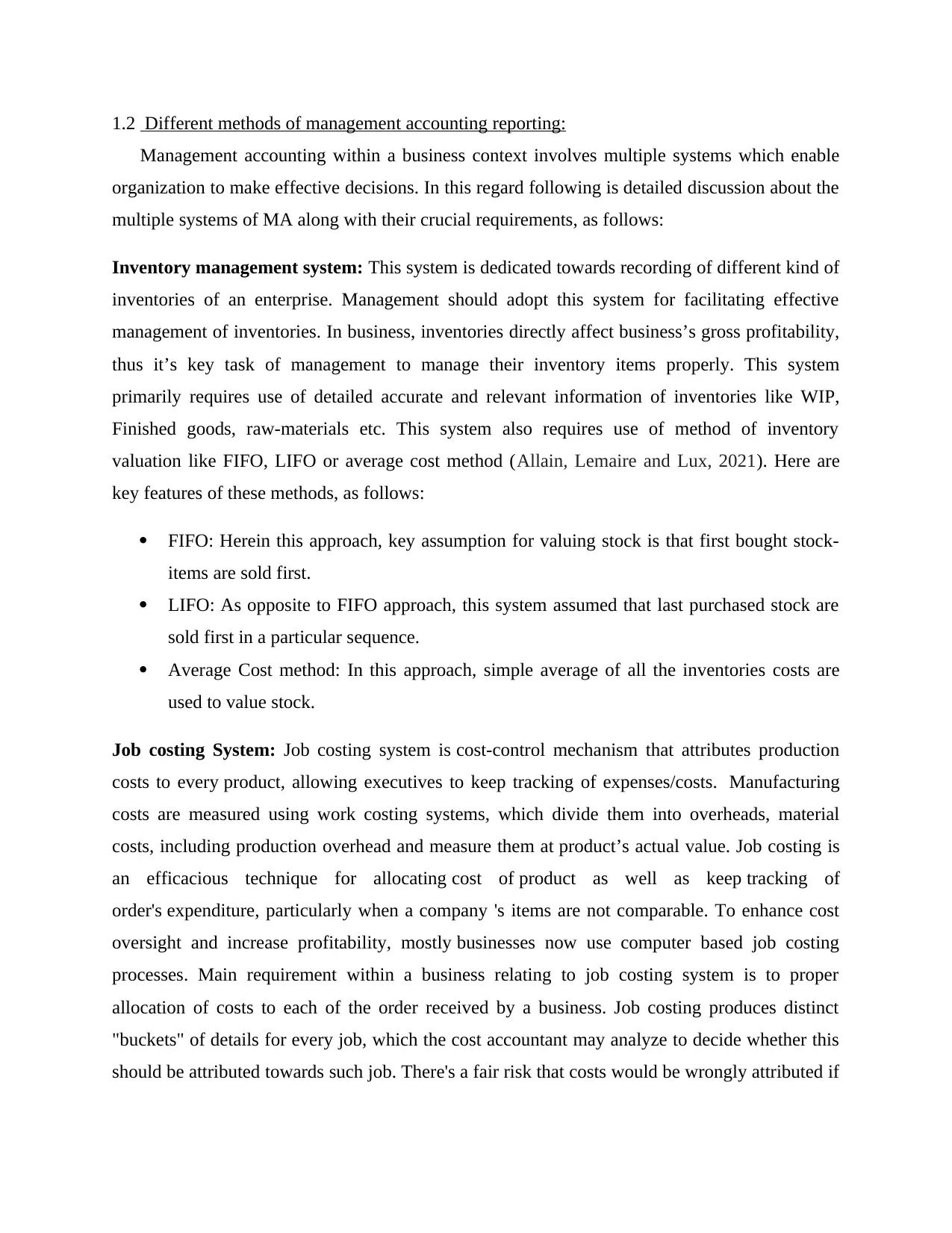
1.2 Different methods of management accounting reporting:
Management accounting within a business context involves multiple systems which enable
organization to make effective decisions. In this regard following is detailed discussion about the
multiple systems of MA along with their crucial requirements, as follows:
Inventory management system: This system is dedicated towards recording of different kind of
inventories of an enterprise. Management should adopt this system for facilitating effective
management of inventories. In business, inventories directly affect business’s gross profitability,
thus it’s key task of management to manage their inventory items properly. This system
primarily requires use of detailed accurate and relevant information of inventories like WIP,
Finished goods, raw-materials etc. This system also requires use of method of inventory
valuation like FIFO, LIFO or average cost method (Allain, Lemaire and Lux, 2021). Here are
key features of these methods, as follows:
FIFO: Herein this approach, key assumption for valuing stock is that first bought stock-
items are sold first.
LIFO: As opposite to FIFO approach, this system assumed that last purchased stock are
sold first in a particular sequence.
Average Cost method: In this approach, simple average of all the inventories costs are
used to value stock.
Job costing System: Job costing system is cost-control mechanism that attributes production
costs to every product, allowing executives to keep tracking of expenses/costs. Manufacturing
costs are measured using work costing systems, which divide them into overheads, material
costs, including production overhead and measure them at product’s actual value. Job costing is
an efficacious technique for allocating cost of product as well as keep tracking of
order's expenditure, particularly when a company 's items are not comparable. To enhance cost
oversight and increase profitability, mostly businesses now use computer based job costing
processes. Main requirement within a business relating to job costing system is to proper
allocation of costs to each of the order received by a business. Job costing produces distinct
"buckets" of details for every job, which the cost accountant may analyze to decide whether this
should be attributed towards such job. There's a fair risk that costs would be wrongly attributed if
Management accounting within a business context involves multiple systems which enable
organization to make effective decisions. In this regard following is detailed discussion about the
multiple systems of MA along with their crucial requirements, as follows:
Inventory management system: This system is dedicated towards recording of different kind of
inventories of an enterprise. Management should adopt this system for facilitating effective
management of inventories. In business, inventories directly affect business’s gross profitability,
thus it’s key task of management to manage their inventory items properly. This system
primarily requires use of detailed accurate and relevant information of inventories like WIP,
Finished goods, raw-materials etc. This system also requires use of method of inventory
valuation like FIFO, LIFO or average cost method (Allain, Lemaire and Lux, 2021). Here are
key features of these methods, as follows:
FIFO: Herein this approach, key assumption for valuing stock is that first bought stock-
items are sold first.
LIFO: As opposite to FIFO approach, this system assumed that last purchased stock are
sold first in a particular sequence.
Average Cost method: In this approach, simple average of all the inventories costs are
used to value stock.
Job costing System: Job costing system is cost-control mechanism that attributes production
costs to every product, allowing executives to keep tracking of expenses/costs. Manufacturing
costs are measured using work costing systems, which divide them into overheads, material
costs, including production overhead and measure them at product’s actual value. Job costing is
an efficacious technique for allocating cost of product as well as keep tracking of
order's expenditure, particularly when a company 's items are not comparable. To enhance cost
oversight and increase profitability, mostly businesses now use computer based job costing
processes. Main requirement within a business relating to job costing system is to proper
allocation of costs to each of the order received by a business. Job costing produces distinct
"buckets" of details for every job, which the cost accountant may analyze to decide whether this
should be attributed towards such job. There's a fair risk that costs would be wrongly attributed if
Paraphrase This Document
Need a fresh take? Get an instant paraphrase of this document with our AI Paraphraser
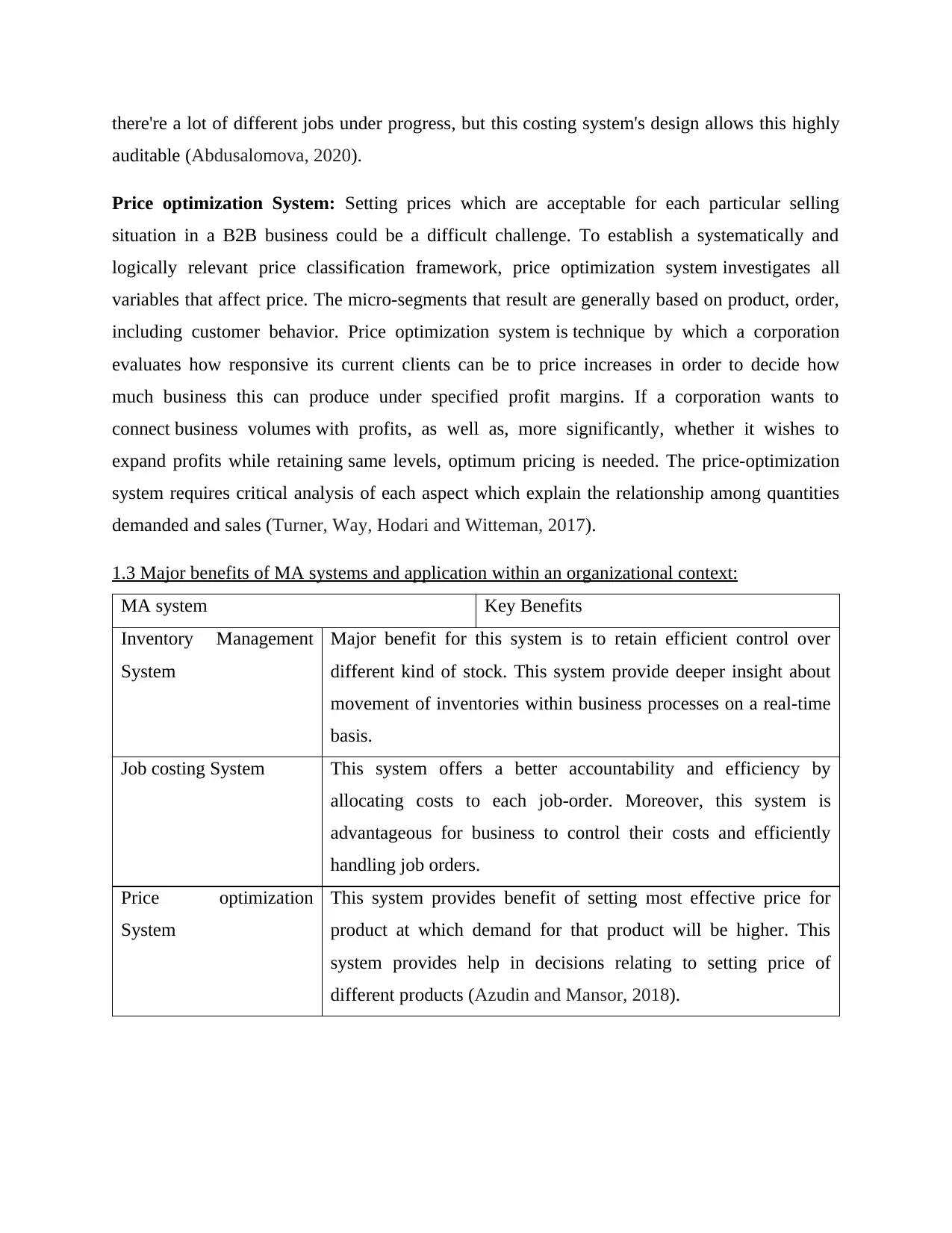
there're a lot of different jobs under progress, but this costing system's design allows this highly
auditable (Abdusalomova, 2020).
Price optimization System: Setting prices which are acceptable for each particular selling
situation in a B2B business could be a difficult challenge. To establish a systematically and
logically relevant price classification framework, price optimization system investigates all
variables that affect price. The micro-segments that result are generally based on product, order,
including customer behavior. Price optimization system is technique by which a corporation
evaluates how responsive its current clients can be to price increases in order to decide how
much business this can produce under specified profit margins. If a corporation wants to
connect business volumes with profits, as well as, more significantly, whether it wishes to
expand profits while retaining same levels, optimum pricing is needed. The price-optimization
system requires critical analysis of each aspect which explain the relationship among quantities
demanded and sales (Turner, Way, Hodari and Witteman, 2017).
1.3 Major benefits of MA systems and application within an organizational context:
MA system Key Benefits
Inventory Management
System
Major benefit for this system is to retain efficient control over
different kind of stock. This system provide deeper insight about
movement of inventories within business processes on a real-time
basis.
Job costing System This system offers a better accountability and efficiency by
allocating costs to each job-order. Moreover, this system is
advantageous for business to control their costs and efficiently
handling job orders.
Price optimization
System
This system provides benefit of setting most effective price for
product at which demand for that product will be higher. This
system provides help in decisions relating to setting price of
different products (Azudin and Mansor, 2018).
auditable (Abdusalomova, 2020).
Price optimization System: Setting prices which are acceptable for each particular selling
situation in a B2B business could be a difficult challenge. To establish a systematically and
logically relevant price classification framework, price optimization system investigates all
variables that affect price. The micro-segments that result are generally based on product, order,
including customer behavior. Price optimization system is technique by which a corporation
evaluates how responsive its current clients can be to price increases in order to decide how
much business this can produce under specified profit margins. If a corporation wants to
connect business volumes with profits, as well as, more significantly, whether it wishes to
expand profits while retaining same levels, optimum pricing is needed. The price-optimization
system requires critical analysis of each aspect which explain the relationship among quantities
demanded and sales (Turner, Way, Hodari and Witteman, 2017).
1.3 Major benefits of MA systems and application within an organizational context:
MA system Key Benefits
Inventory Management
System
Major benefit for this system is to retain efficient control over
different kind of stock. This system provide deeper insight about
movement of inventories within business processes on a real-time
basis.
Job costing System This system offers a better accountability and efficiency by
allocating costs to each job-order. Moreover, this system is
advantageous for business to control their costs and efficiently
handling job orders.
Price optimization
System
This system provides benefit of setting most effective price for
product at which demand for that product will be higher. This
system provides help in decisions relating to setting price of
different products (Azudin and Mansor, 2018).
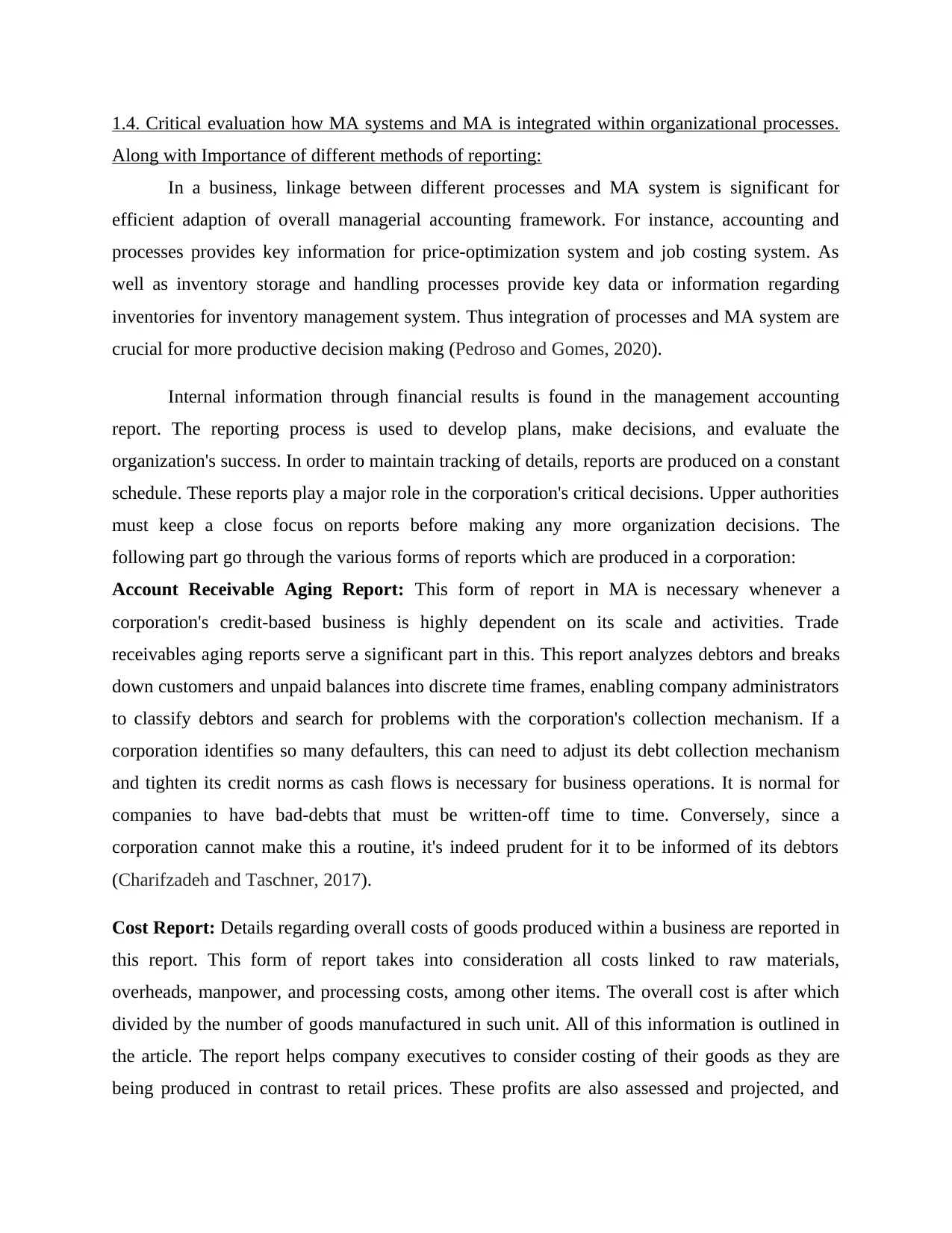
1.4. Critical evaluation how MA systems and MA is integrated within organizational processes.
Along with Importance of different methods of reporting:
In a business, linkage between different processes and MA system is significant for
efficient adaption of overall managerial accounting framework. For instance, accounting and
processes provides key information for price-optimization system and job costing system. As
well as inventory storage and handling processes provide key data or information regarding
inventories for inventory management system. Thus integration of processes and MA system are
crucial for more productive decision making (Pedroso and Gomes, 2020).
Internal information through financial results is found in the management accounting
report. The reporting process is used to develop plans, make decisions, and evaluate the
organization's success. In order to maintain tracking of details, reports are produced on a constant
schedule. These reports play a major role in the corporation's critical decisions. Upper authorities
must keep a close focus on reports before making any more organization decisions. The
following part go through the various forms of reports which are produced in a corporation:
Account Receivable Aging Report: This form of report in MA is necessary whenever a
corporation's credit-based business is highly dependent on its scale and activities. Trade
receivables aging reports serve a significant part in this. This report analyzes debtors and breaks
down customers and unpaid balances into discrete time frames, enabling company administrators
to classify debtors and search for problems with the corporation's collection mechanism. If a
corporation identifies so many defaulters, this can need to adjust its debt collection mechanism
and tighten its credit norms as cash flows is necessary for business operations. It is normal for
companies to have bad-debts that must be written-off time to time. Conversely, since a
corporation cannot make this a routine, it's indeed prudent for it to be informed of its debtors
(Charifzadeh and Taschner, 2017).
Cost Report: Details regarding overall costs of goods produced within a business are reported in
this report. This form of report takes into consideration all costs linked to raw materials,
overheads, manpower, and processing costs, among other items. The overall cost is after which
divided by the number of goods manufactured in such unit. All of this information is outlined in
the article. The report helps company executives to consider costing of their goods as they are
being produced in contrast to retail prices. These profits are also assessed and projected, and
Along with Importance of different methods of reporting:
In a business, linkage between different processes and MA system is significant for
efficient adaption of overall managerial accounting framework. For instance, accounting and
processes provides key information for price-optimization system and job costing system. As
well as inventory storage and handling processes provide key data or information regarding
inventories for inventory management system. Thus integration of processes and MA system are
crucial for more productive decision making (Pedroso and Gomes, 2020).
Internal information through financial results is found in the management accounting
report. The reporting process is used to develop plans, make decisions, and evaluate the
organization's success. In order to maintain tracking of details, reports are produced on a constant
schedule. These reports play a major role in the corporation's critical decisions. Upper authorities
must keep a close focus on reports before making any more organization decisions. The
following part go through the various forms of reports which are produced in a corporation:
Account Receivable Aging Report: This form of report in MA is necessary whenever a
corporation's credit-based business is highly dependent on its scale and activities. Trade
receivables aging reports serve a significant part in this. This report analyzes debtors and breaks
down customers and unpaid balances into discrete time frames, enabling company administrators
to classify debtors and search for problems with the corporation's collection mechanism. If a
corporation identifies so many defaulters, this can need to adjust its debt collection mechanism
and tighten its credit norms as cash flows is necessary for business operations. It is normal for
companies to have bad-debts that must be written-off time to time. Conversely, since a
corporation cannot make this a routine, it's indeed prudent for it to be informed of its debtors
(Charifzadeh and Taschner, 2017).
Cost Report: Details regarding overall costs of goods produced within a business are reported in
this report. This form of report takes into consideration all costs linked to raw materials,
overheads, manpower, and processing costs, among other items. The overall cost is after which
divided by the number of goods manufactured in such unit. All of this information is outlined in
the article. The report helps company executives to consider costing of their goods as they are
being produced in contrast to retail prices. These profits are also assessed and projected, and
⊘ This is a preview!⊘
Do you want full access?
Subscribe today to unlock all pages.

Trusted by 1+ million students worldwide
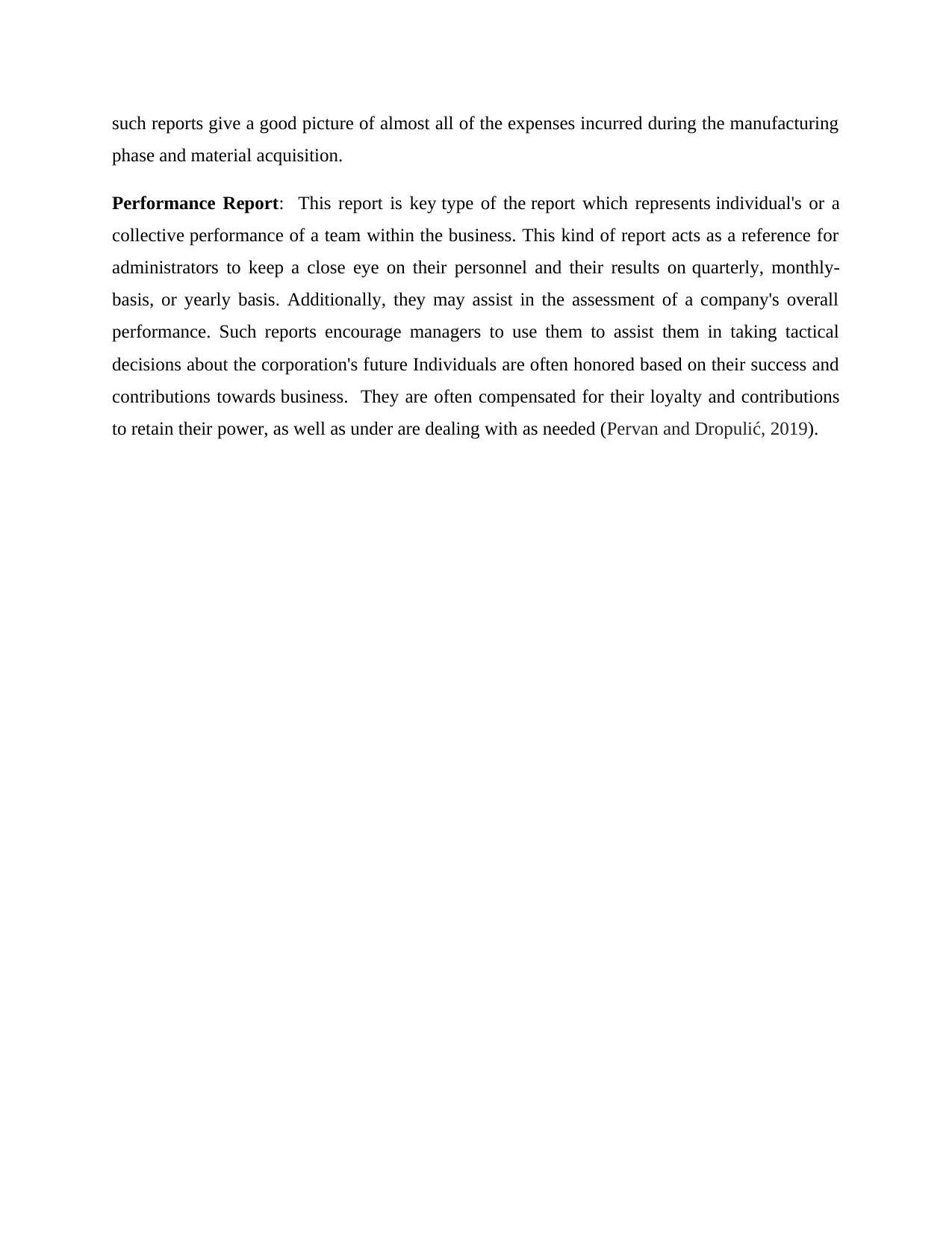
such reports give a good picture of almost all of the expenses incurred during the manufacturing
phase and material acquisition.
Performance Report: This report is key type of the report which represents individual's or a
collective performance of a team within the business. This kind of report acts as a reference for
administrators to keep a close eye on their personnel and their results on quarterly, monthly-
basis, or yearly basis. Additionally, they may assist in the assessment of a company's overall
performance. Such reports encourage managers to use them to assist them in taking tactical
decisions about the corporation's future Individuals are often honored based on their success and
contributions towards business. They are often compensated for their loyalty and contributions
to retain their power, as well as under are dealing with as needed (Pervan and Dropulić, 2019).
phase and material acquisition.
Performance Report: This report is key type of the report which represents individual's or a
collective performance of a team within the business. This kind of report acts as a reference for
administrators to keep a close eye on their personnel and their results on quarterly, monthly-
basis, or yearly basis. Additionally, they may assist in the assessment of a company's overall
performance. Such reports encourage managers to use them to assist them in taking tactical
decisions about the corporation's future Individuals are often honored based on their success and
contributions towards business. They are often compensated for their loyalty and contributions
to retain their power, as well as under are dealing with as needed (Pervan and Dropulić, 2019).
Paraphrase This Document
Need a fresh take? Get an instant paraphrase of this document with our AI Paraphraser
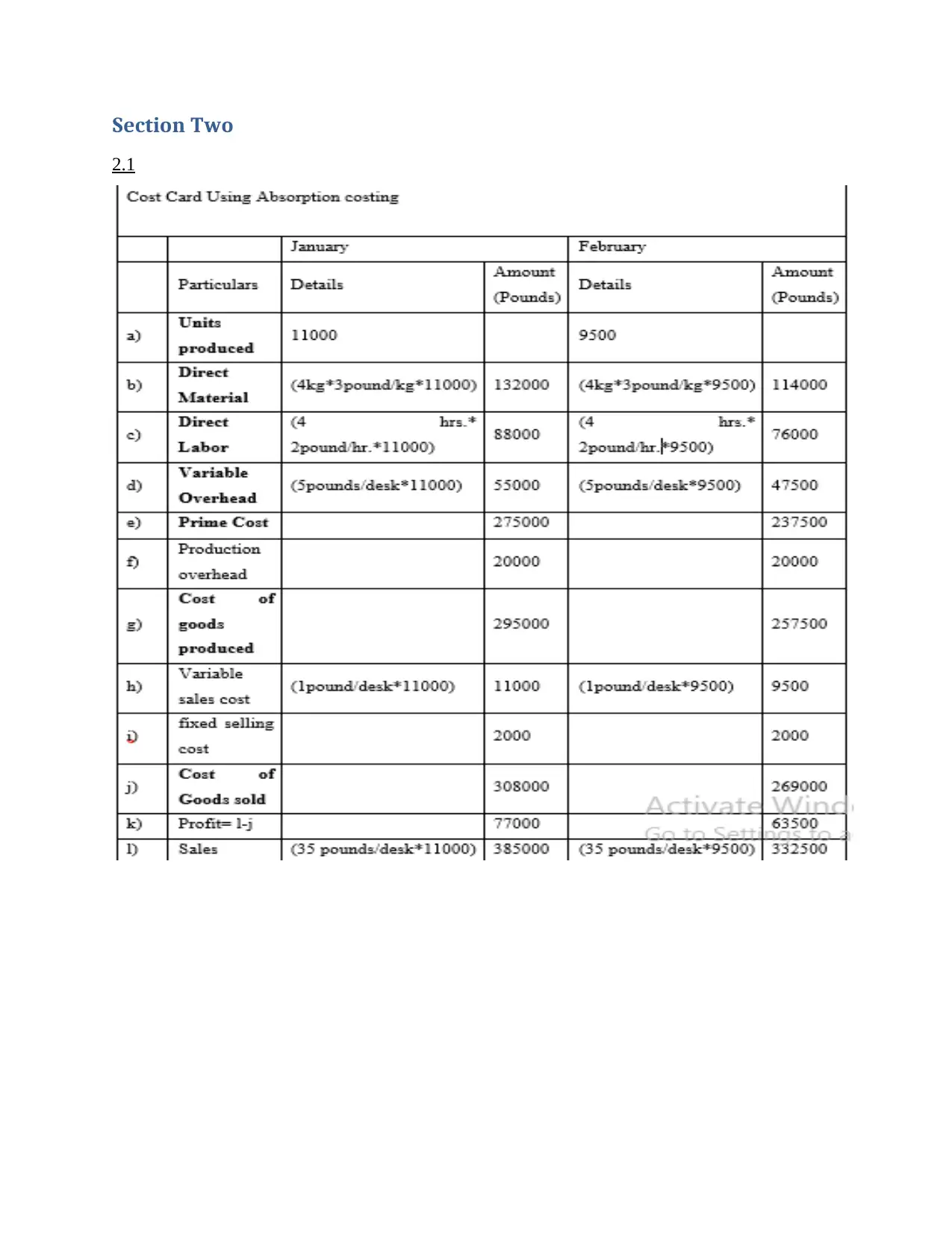
Section Two
2.1
2.1
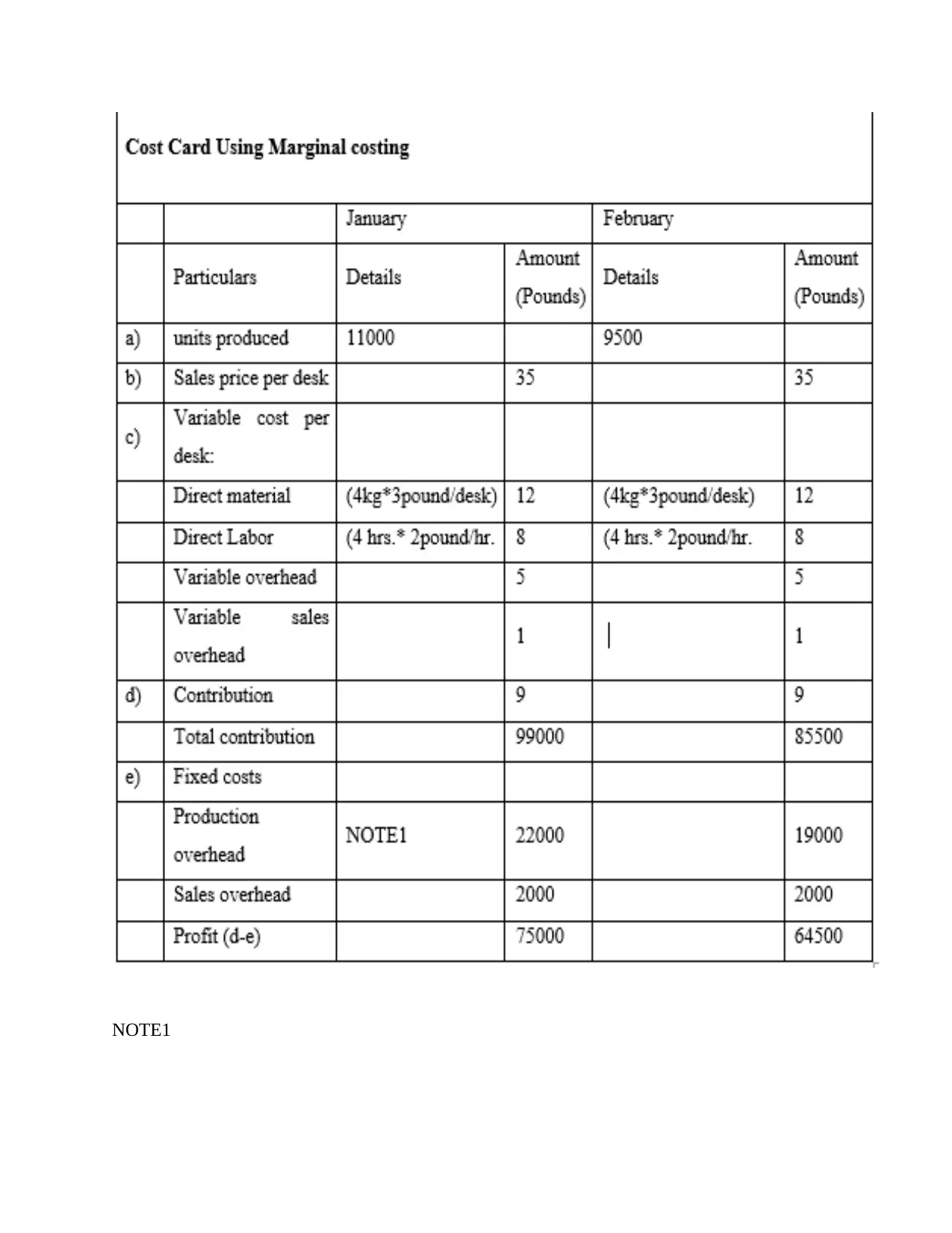
NOTE1
⊘ This is a preview!⊘
Do you want full access?
Subscribe today to unlock all pages.

Trusted by 1+ million students worldwide
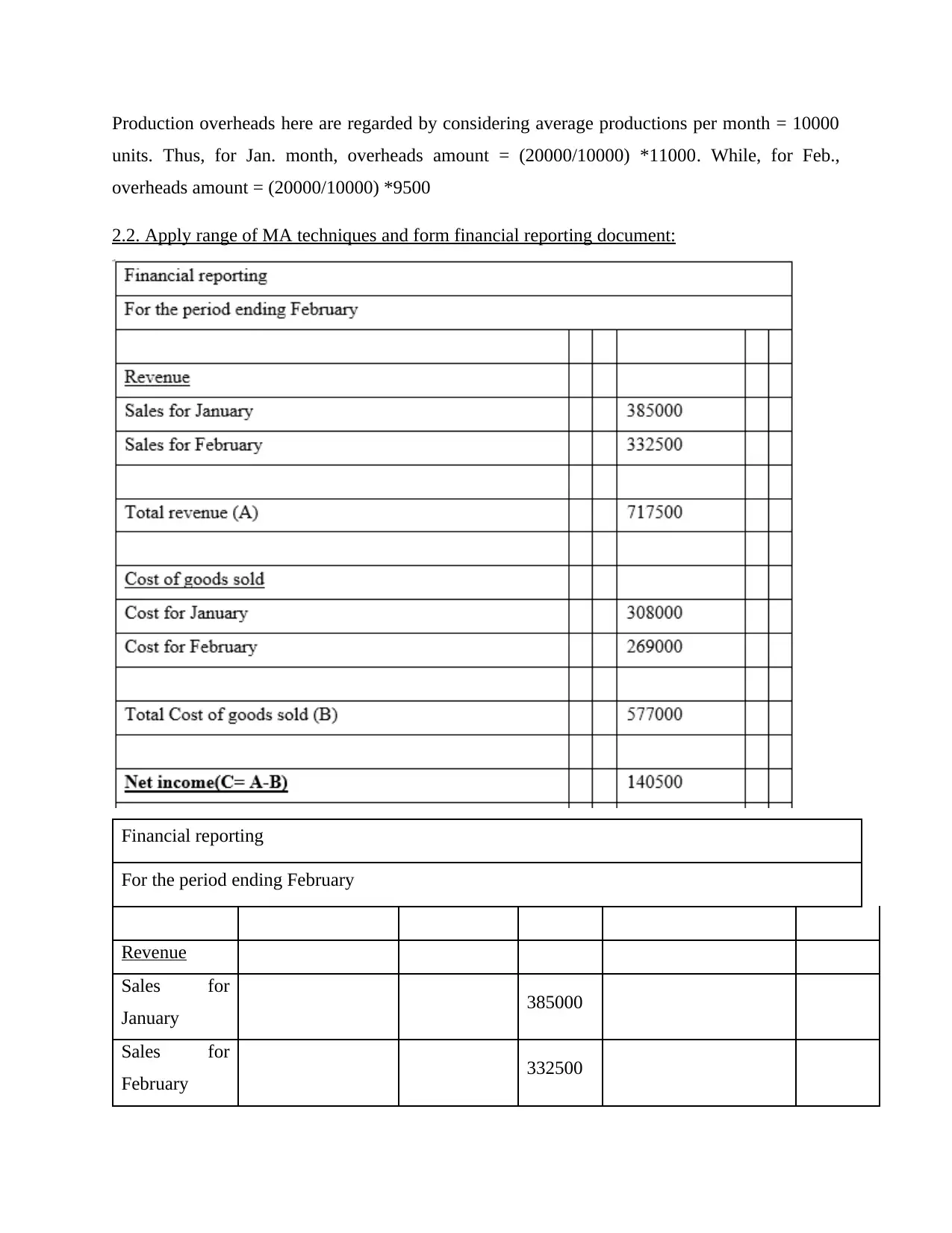
Production overheads here are regarded by considering average productions per month = 10000
units. Thus, for Jan. month, overheads amount = (20000/10000) *11000. While, for Feb.,
overheads amount = (20000/10000) *9500
2.2. Apply range of MA techniques and form financial reporting document:
Financial reporting
For the period ending February
Revenue
Sales for
January 385000
Sales for
February 332500
units. Thus, for Jan. month, overheads amount = (20000/10000) *11000. While, for Feb.,
overheads amount = (20000/10000) *9500
2.2. Apply range of MA techniques and form financial reporting document:
Financial reporting
For the period ending February
Revenue
Sales for
January 385000
Sales for
February 332500
Paraphrase This Document
Need a fresh take? Get an instant paraphrase of this document with our AI Paraphraser
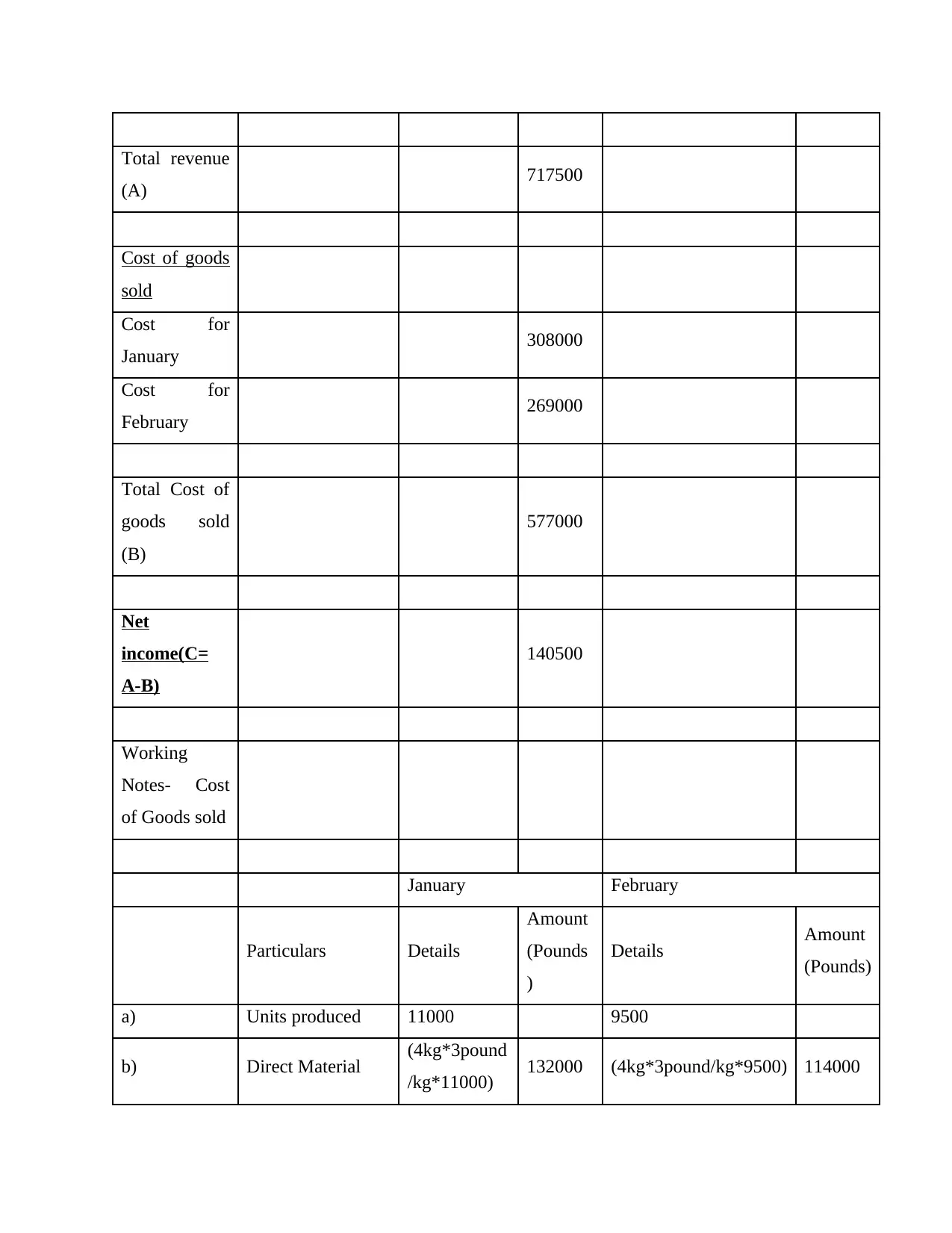
Total revenue
(A) 717500
Cost of goods
sold
Cost for
January 308000
Cost for
February 269000
Total Cost of
goods sold
(B)
577000
Net
income(C=
A-B)
140500
Working
Notes- Cost
of Goods sold
January February
Particulars Details
Amount
(Pounds
)
Details Amount
(Pounds)
a) Units produced 11000 9500
b) Direct Material (4kg*3pound
/kg*11000) 132000 (4kg*3pound/kg*9500) 114000
(A) 717500
Cost of goods
sold
Cost for
January 308000
Cost for
February 269000
Total Cost of
goods sold
(B)
577000
Net
income(C=
A-B)
140500
Working
Notes- Cost
of Goods sold
January February
Particulars Details
Amount
(Pounds
)
Details Amount
(Pounds)
a) Units produced 11000 9500
b) Direct Material (4kg*3pound
/kg*11000) 132000 (4kg*3pound/kg*9500) 114000
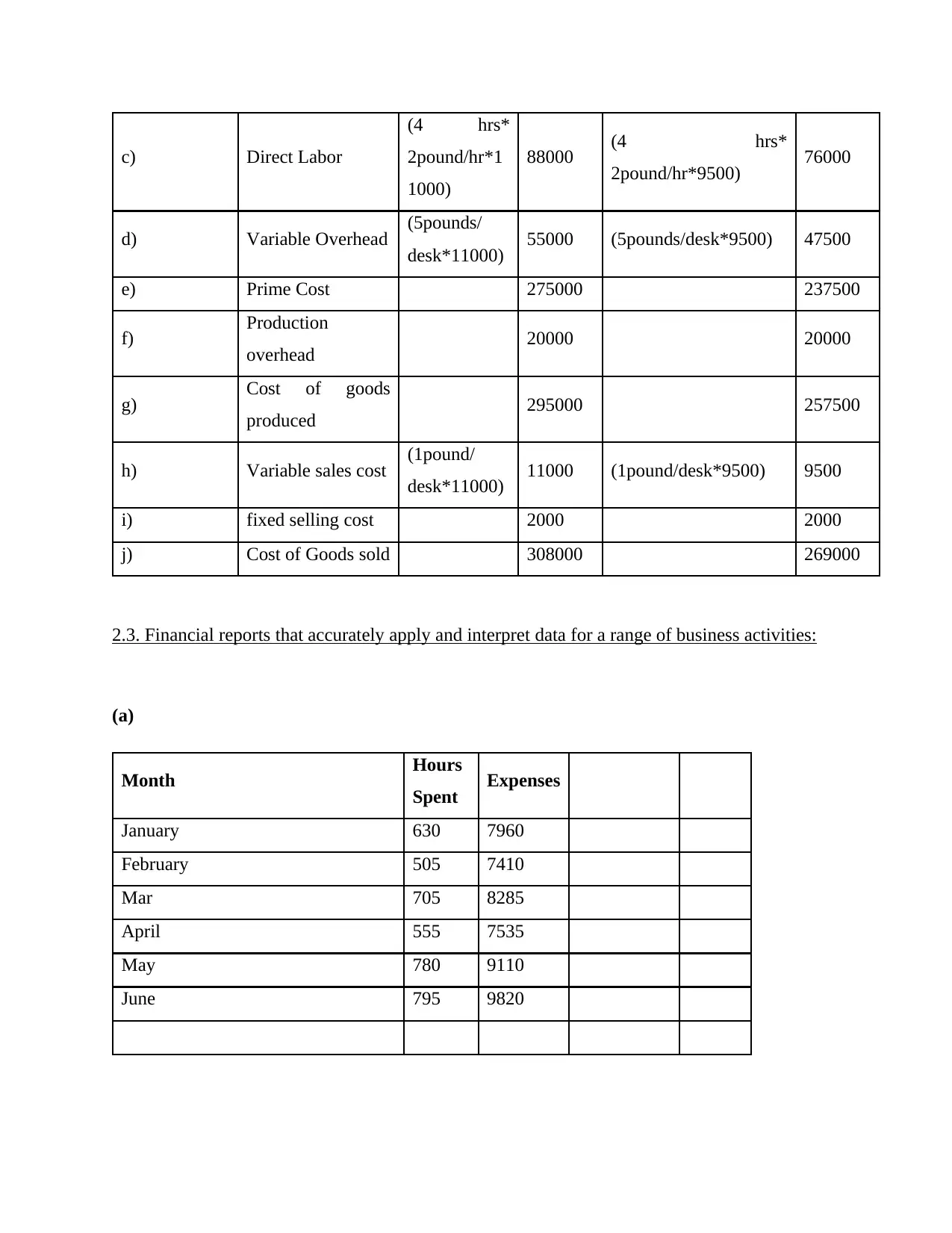
c) Direct Labor
(4 hrs*
2pound/hr*1
1000)
88000 (4 hrs*
2pound/hr*9500) 76000
d) Variable Overhead (5pounds/
desk*11000) 55000 (5pounds/desk*9500) 47500
e) Prime Cost 275000 237500
f) Production
overhead 20000 20000
g) Cost of goods
produced 295000 257500
h) Variable sales cost (1pound/
desk*11000) 11000 (1pound/desk*9500) 9500
i) fixed selling cost 2000 2000
j) Cost of Goods sold 308000 269000
2.3. Financial reports that accurately apply and interpret data for a range of business activities:
(a)
Month Hours
Spent Expenses
January 630 7960
February 505 7410
Mar 705 8285
April 555 7535
May 780 9110
June 795 9820
(4 hrs*
2pound/hr*1
1000)
88000 (4 hrs*
2pound/hr*9500) 76000
d) Variable Overhead (5pounds/
desk*11000) 55000 (5pounds/desk*9500) 47500
e) Prime Cost 275000 237500
f) Production
overhead 20000 20000
g) Cost of goods
produced 295000 257500
h) Variable sales cost (1pound/
desk*11000) 11000 (1pound/desk*9500) 9500
i) fixed selling cost 2000 2000
j) Cost of Goods sold 308000 269000
2.3. Financial reports that accurately apply and interpret data for a range of business activities:
(a)
Month Hours
Spent Expenses
January 630 7960
February 505 7410
Mar 705 8285
April 555 7535
May 780 9110
June 795 9820
⊘ This is a preview!⊘
Do you want full access?
Subscribe today to unlock all pages.

Trusted by 1+ million students worldwide
1 out of 29
Related Documents
Your All-in-One AI-Powered Toolkit for Academic Success.
+13062052269
info@desklib.com
Available 24*7 on WhatsApp / Email
![[object Object]](/_next/static/media/star-bottom.7253800d.svg)
Unlock your academic potential
Copyright © 2020–2025 A2Z Services. All Rights Reserved. Developed and managed by ZUCOL.





